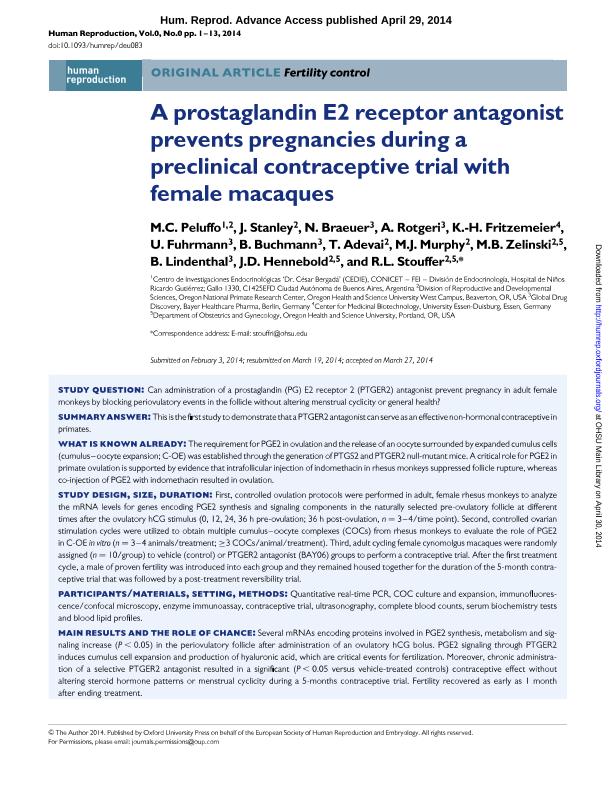Mostrar el registro sencillo del ítem
dc.contributor.author
Peluffo, Marina Cinthia

dc.contributor.author
Stanley, J.
dc.contributor.author
Braeuer, N.
dc.contributor.author
Rotgeri, A.
dc.contributor.author
Fritzemeier, K. H.
dc.contributor.author
Fuhrmann, U.
dc.contributor.author
Buchmann, B.
dc.contributor.author
Adevai, T.
dc.contributor.author
Murphy, M. J.
dc.contributor.author
Zelinski, M. B.
dc.contributor.author
Lindenthal, B.
dc.contributor.author
Hennebold, J. D.
dc.contributor.author
Stouffer, R. L.
dc.date.available
2016-11-14T18:40:31Z
dc.date.issued
2014-03
dc.identifier.citation
Peluffo, Marina Cinthia; Stanley, J.; Braeuer, N.; Rotgeri, A.; Fritzemeier, K. H.; et al.; A prostaglandin E2 receptor antagonist prevents pregnancies during a preclinical contraceptive trial with female macaques; Oxford University Press; Human Reproduction; 29; 7; 3-2014; 1400-1412
dc.identifier.issn
0268-1161
dc.identifier.uri
http://hdl.handle.net/11336/8189
dc.description.abstract
STUDY QUESTION
Can administration of a prostaglandin (PG) E2 receptor 2 (PTGER2) antagonist prevent pregnancy in adult female monkeys by blocking periovulatory events in the follicle without altering menstrual cyclicity or general health?
SUMMARY ANSWER
This is the first study to demonstrate that a PTGER2 antagonist can serve as an effective non-hormonal contraceptive in primates.
WHAT IS KNOWN ALREADY
The requirement for PGE2 in ovulation and the release of an oocyte surrounded by expanded cumulus cells (cumulus–oocyte expansion; C-OE) was established through the generation of PTGS2 and PTGER2 null-mutant mice. A critical role for PGE2 in primate ovulation is supported by evidence that intrafollicular injection of indomethacin in rhesus monkeys suppressed follicle rupture, whereas co-injection of PGE2 with indomethacin resulted in ovulation.
STUDY DESIGN, SIZE, DURATION
First, controlled ovulation protocols were performed in adult, female rhesus monkeys to analyze the mRNA levels for genes encoding PGE2 synthesis and signaling components in the naturally selected pre-ovulatory follicle at different times after the ovulatory hCG stimulus (0, 12, 24, 36 h pre-ovulation; 36 h post-ovulation, n = 3–4/time point). Second, controlled ovarian stimulation cycles were utilized to obtain multiple cumulus–oocyte complexes (COCs) from rhesus monkeys to evaluate the role of PGE2 in C-OE in vitro (n = 3–4 animals/treatment; ≥3 COCs/animal/treatment). Third, adult cycling female cynomolgus macaques were randomly assigned (n = 10/group) to vehicle (control) or PTGER2 antagonist (BAY06) groups to perform a contraceptive trial. After the first treatment cycle, a male of proven fertility was introduced into each group and they remained housed together for the duration of the 5-month contraceptive trial that was followed by a post-treatment reversibility trial.
PARTICIPANTS/MATERIALS, SETTING, METHODS
Quantitative real-time PCR, COC culture and expansion, immunofluorescence/confocal microscopy, enzyme immunoassay, contraceptive trial, ultrasonography, complete blood counts, serum biochemistry tests and blood lipid profiles.
MAIN RESULTS AND THE ROLE OF CHANCE
Several mRNAs encoding proteins involved in PGE2 synthesis, metabolism and signaling increase (P < 0.05) in the periovulatory follicle after administration of an ovulatory hCG bolus. PGE2 signaling through PTGER2 induces cumulus cell expansion and production of hyaluronic acid, which are critical events for fertilization. Moreover, chronic administration of a selective PTGER2 antagonist resulted in a significant (P < 0.05 versus vehicle-treated controls) contraceptive effect without altering steroid hormone patterns or menstrual cyclicity during a 5-months contraceptive trial. Fertility recovered as early as 1 month after ending treatment.
LIMITATIONS, REASONS FOR CAUTION
This is a proof-of-concept study in a non-human primate model. Further investigations are warranted to elucidate the mechanism(s) of PTGER2 antagonist action in the primate ovary. Although PTGER2 antagonist treatment did not produce any obvious undesirable effects, improvements in the mode of administration, as well as the efficacy of these compounds, are necessary to consider such a contraceptive for women.
WIDER IMPLICATIONS OF THE FINDINGS
Monitoring as well as improving the efficacy and safety of female contraceptives is an important public health activity. Even though hormonal contraceptives are effective for women, concerns remain regarding their side-effects and long-term use because of the widespread actions of such steroidal products in many tissues. Moreover, some women cannot take hormones for medical reasons. Thus, development of non-hormonal contraceptives for women is warranted.
STUDY FUNDING/COMPETING INTEREST(S)
Supported by Bayer HealthCare Pharmaceuticals, The Eunice Kennedy Shriver NICHD Contraceptive Development and Research Center (U54 HD055744), NIH Office of the Director (Oregon National Primate Research Center P51 OD011092), and a Lalor Foundation Postdoctoral Basic Research Fellowship (MCP). The use of the Leica confocal was supported by grant number S10RR024585. Some of the authors (N.B., A.R., K.-H.F., U.F., B.B. and B.L.) are employees of Bayer Healthcare Pharma.
dc.format
application/pdf
dc.language.iso
eng
dc.publisher
Oxford University Press

dc.rights
info:eu-repo/semantics/openAccess
dc.rights.uri
https://creativecommons.org/licenses/by-nc-sa/2.5/ar/
dc.subject
Prostaglandin E2 Receptor
dc.subject
Cumulus Oocyte Expansion
dc.subject
Contraceptive Trial
dc.subject
Primates
dc.subject.classification
Otras Medicina Básica

dc.subject.classification
Medicina Básica

dc.subject.classification
CIENCIAS MÉDICAS Y DE LA SALUD

dc.title
A prostaglandin E2 receptor antagonist prevents pregnancies during a preclinical contraceptive trial with female macaques
dc.type
info:eu-repo/semantics/article
dc.type
info:ar-repo/semantics/artículo
dc.type
info:eu-repo/semantics/publishedVersion
dc.date.updated
2016-11-11T18:15:44Z
dc.journal.volume
29
dc.journal.number
7
dc.journal.pagination
1400-1412
dc.journal.pais
Reino Unido

dc.journal.ciudad
Oxford
dc.description.fil
Fil: Peluffo, Marina Cinthia. Consejo Nacional de Investigaciones Científicas y Técnicas. Oficina de Coordinación Administrativa Parque Centenario. Centro de Investigaciones Endocrinológicas; Argentina
dc.description.fil
Fil: Stanley, J.. Oregon National Primate Research Center; Estados Unidos
dc.description.fil
Fil: Braeuer, N.. Bayer Healthcare Pharma; Alemania
dc.description.fil
Fil: Rotgeri, A.. Bayer Healthcare Pharma; Alemania
dc.description.fil
Fil: Fritzemeier, K. H.. Universitat Duisburg - Essen; Alemania
dc.description.fil
Fil: Fuhrmann, U.. Bayer Healthcare Pharma; Alemania
dc.description.fil
Fil: Buchmann, B.. Bayer Healthcare Pharma; Alemania
dc.description.fil
Fil: Adevai, T.. Oregon National Primate Research Center; Estados Unidos
dc.description.fil
Fil: Murphy, M. J.. Oregon National Primate Research Center; Estados Unidos
dc.description.fil
Fil: Zelinski, M. B.. Oregon Health and Science University; Estados Unidos
dc.description.fil
Fil: Lindenthal, B.. Bayer Healthcare Pharma; Alemania
dc.description.fil
Fil: Hennebold, J. D.. Oregon National Primate Research Center; Estados Unidos. Oregon Health and Science University; Estados Unidos
dc.description.fil
Fil: Stouffer, R. L.. Oregon National Primate Research Center; Estados Unidos. Oregon Health and Science University; Estados Unidos
dc.journal.title
Human Reproduction

dc.relation.alternativeid
info:eu-repo/semantics/altIdentifier/url/http://humrep.oxfordjournals.org/content/29/7/1400.long
dc.relation.alternativeid
info:eu-repo/semantics/altIdentifier/url/https://www.ncbi.nlm.nih.gov/pmc/articles/PMC4059334/
dc.relation.alternativeid
info:eu-repo/semantics/altIdentifier/doi/http://dx.doi.org/10.1093/humrep/deu083
Archivos asociados
